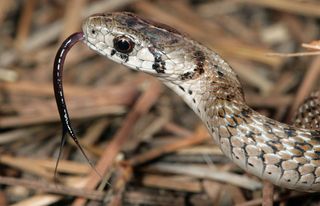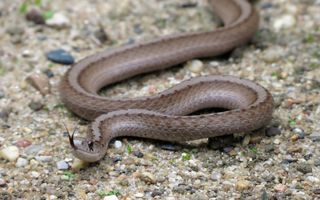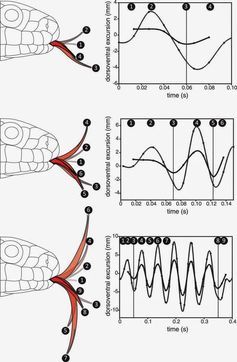
Explainer: Why Do Snakes Flick Their Tongues?

This article was originally published at The Conversation.The publication contributed the article to Live Science's Expert Voices: Op-Ed & Insights.
Many people think a snake’s forked tongue is creepy. Every so often, the snake waves it around rapidly, then retracts it. Theories explaining the forked tongues of snakes have been around for thousands of years. Aristotle reasoned that it provided snakes with “a twofold pleasure from savours, their gustatory sensation being as it were doubled”.
Italian astronomer Giovanni Hodierna thought snake tongues were for cleaning dirt out of their noses. Some 17th century writers claimed to have watched snakes catch flies or other animals between the forks of their tongues, using them like forceps. It is a common myth even today that snakes can sting you with their tongues. But none of those hypotheses is likely.
Most animals with tongues use them for tasting, to clean themselves or others, or to capture or manipulate their prey. A few, including humans, also use them to make sounds. Snakes do not use their tongues for any of these things. Over the past 20 years, Kurt Schwenk, an evolutionary biologist at the University of Connecticut, has been working on understanding the function of snake tongues, and “smelling” is the closest description of what snakes do with their tongues.
Tongues that smell
Snakes use their tongues for collecting chemicals from the air or ground. The tongue does not have receptors to taste or smell. Instead, these receptors are in the vomeronasal, or Jacobson’s Organ, which is in the roof of the mouth. Once inside the Jacobson’s Organ, different chemicals evoke different electrical signals which are relayed to the brain.
It was once thought that the tongue delivered chemicals directly to the Jacobson’s Organ, because both the organ and the pathways that lead to it are paired just like the tips of the tongue. But X-ray movies have revealed that the tongue does not move inside the closed mouth, it simply deposits the chemicals it has collected onto pads on the floor of the mouth as the mouth is closing.
It is most likely that these pads deliver the sampled molecules to the entrance of the Jacobson’s Organ when the floor of the mouth is elevated to come into contact with the roof following a tongue flick. The case for this is strengthened because geckos, skinks, and other lizards lack deeply-forked tongues but still deliver chemicals to their vomeronasal organs.
Sign up for the Live Science daily newsletter now
Get the world’s most fascinating discoveries delivered straight to your inbox.

Smelling in 3-D
Because it is forked, the tongue of a snake can collect chemical information from two different places at once, albeit places that are fairly close together by human standards. When snakes spread the tips of their tongues apart, the distance can be twice as wide as their head. This is important because it allows them to detect chemical gradients in the environment, which gives them a sense of direction – in other words, snakes use their forked tongues to help them smell in three dimensions. Owls use their asymmetrical ears in this way to detect sound in three dimensions.
Snakes and owls use similar neural circuitry to compare the signal strength delivered from each side of the body and determine the direction that a smell or a sound is coming from. Humans do this with their hearing too, but not as effectively.
This makes it possible for snakes to follow trails left by their prey or potential mates. In the 1930s, before guidelines on the ethical use of animals in research were as strict, German biologist Herman Kahmann experimentally removed the forked part of snakes' tongues and found that they could still respond to smells, but that they had lost their ability to follow scent trails. These results were refined and confirmed during the 1970s.

Sniffing out sex
In the 1980s, snake biologist Neil Ford at the University of Texas at Tyler watched how male garter snakes used their tongues when they were following pheromone trails left behind by females. He found that if both tips of the male snake’s tongue fell within the width of the trail, the snake continued slithering straight ahead. However, when one tip or the other fell outside the edge of the trail, the snake turned his head away from that tip and back towards the pheromone trail, and his body followed.
Following this simple rule allowed the snakes to perform trail-following behaviour that was both accurate and directed. If both tongue tips ever touched the ground outside of the trail, the male would stop and swing his head back and forth, tongue-flicking, until he relocated the trail.
Snake ecologist Chuck Smith at Wofford College found evidence that male Copperheads have longer, more deeply-forked tongues than females, which presumably enhances their ability to find mates. Although sexual dimorphism – where one sex is markedly different from the other – is rare in snakes, differences in tongue size are likely to be present in other species as well.
Scent-trailing is probably also quite helpful to snakes tracking down prey, including for sit-and-wait predators like vipers, which have evolved smelly but non-toxic venom components to help them relocate their bitten and envenomated prey.

When following a scent-trail, snakes simply touch their tongue tips down to the ground to pick up the chemical information lying there. But snakes can also use a different type of tongue-flick to sample airborne chemicals.
Snakes often wave their tongues in the air without putting them in contact with anything. The tongue creates air vortices, such as those formed in the water behind a boat. These vortices drift away from the boat as they form. Bill Ryerson, a student in the Schwenk lab, found that vortices created in the air by snake tongues have a special property – they do not drift away but rather stay in the vicinity of the tongue, where they can be sampled repeatedly as the tongue skirts the part of each vortex where the air velocity is the highest.
Oscillating tongue-flicks are unique to snakes. They allow snakes to sample 100 times as much air as the simple downward extension of the tongue. The tongue then transfers these molecules to the Jacobson’s Organ via the mouth floor. Evidence suggests that male Copperheads can also find and follow females using oscillating tongue-flicks to detect airborne pheromones, although the details of how they determine direction using such dispersed and transient odours are still poorly understood.
Andrew Durso does not work for, consult to, own shares in or receive funding from any company or organisation that would benefit from this article, and has no relevant affiliations.
This article was originally published on The Conversation. Read the original article. Follow all of the Expert Voices issues and debates — and become part of the discussion — on Facebook, Twitter and Google +. The views expressed are those of the author and do not necessarily reflect the views of the publisher. This version of the article was originally published on Live Science.
Most Popular

